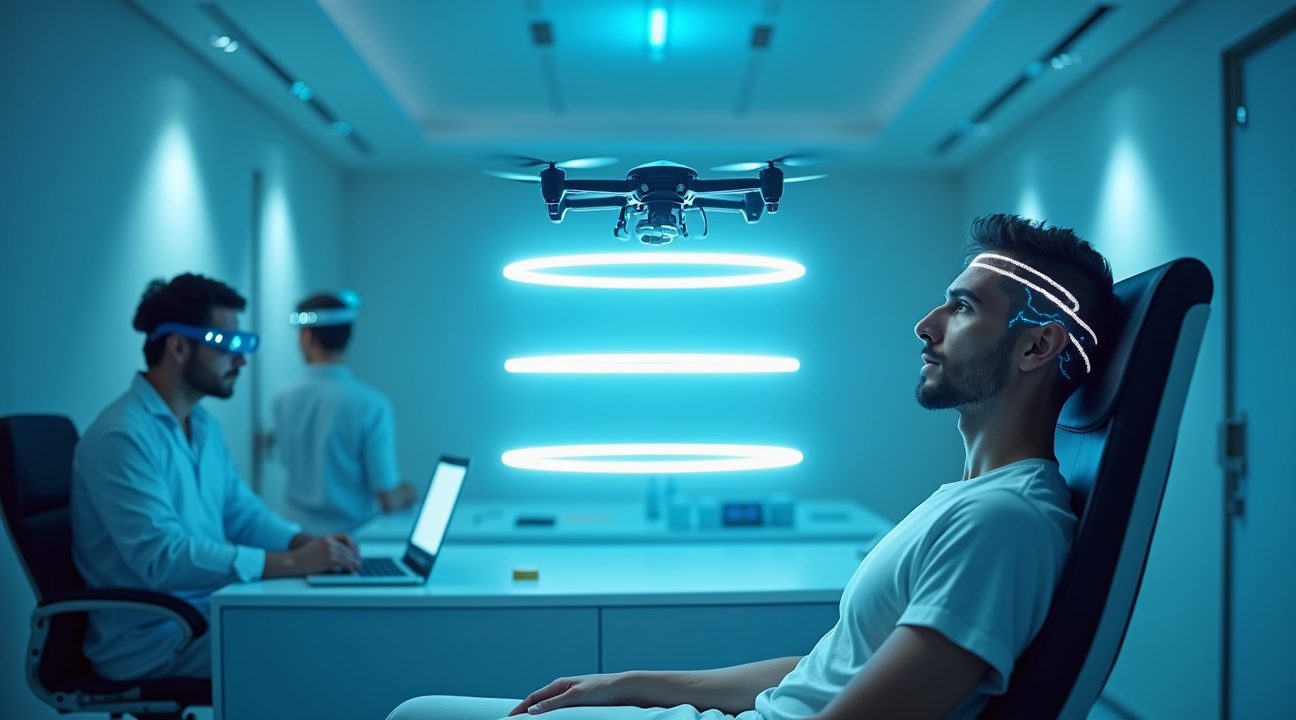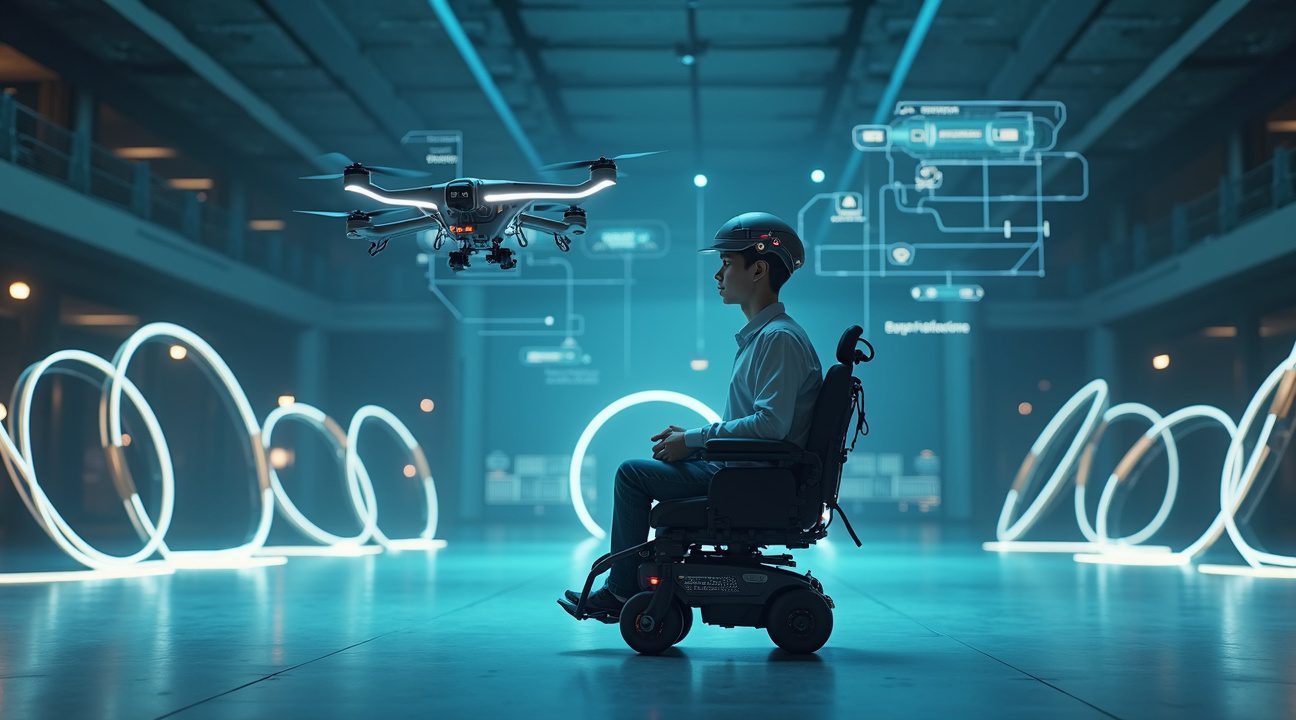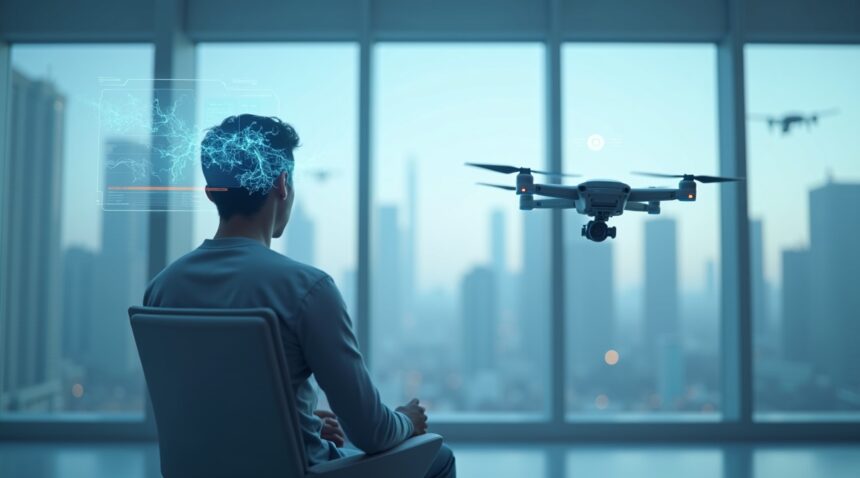Elon Musk’s Neuralink has achieved a pioneering milestone, as its second implanted patient successfully piloted a drone using only thought, signaling a remarkable advancement in brain-computer interface (BCI) technology.
Key Takeaways
- The second implanted patient—a spinal cord injury sufferer—demonstrated advanced drone control using neural signals alone, showcasing a leap from basic computer cursor navigation to dynamic, real-time, three-dimensional operation.
- The N1 chip from Neuralink incorporates 1,024 ultra-thin electrodes embedded in the motor cortex, capturing neural activity and converting it into commands sent wirelessly via Bluetooth to external devices.
- FDA-approved clinical trials are now being conducted on a global scale, reflecting a growing confidence in the safety and clinical potential of Neuralink’s brain implants for treating paralysis and mobility disorders.
- This medical advancement shows that BCIs can significantly enhance the independence of individuals with limited mobility by enabling control of prosthetic limbs, wheelchairs, and smart home systems using only thoughts.
- The successful drone control task indicates that BCI technology has matured from lab-based research to real-world applications, offering transformative tools for assistive technology and neurorehabilitation.
Further Reading
To explore more about this technological leap, you can visit Neuralink’s official website for announcements, research findings, and updates on ongoing clinical trials.
Second Patient Successfully Pilots Drone Using Only Thoughts
Neuralink’s second implanted patient achieved something remarkable – he controlled a drone using nothing but his thoughts. This groundbreaking demonstration marks a significant leap forward in brain-computer interface technology, moving far beyond the basic cursor movements and simple device interactions that characterized earlier milestones.
Breaking New Ground in Neural Control
The patient, who lives with a spinal cord injury, showed how advanced brain-computer interfaces can restore complex motor functions through external devices. His ability to pilot a drone represents a fundamental shift in what’s possible with neural implants. Previous demonstrations focused primarily on computer cursor control or basic robotic arm movements, but this achievement opens doors to sophisticated three-dimensional control systems.
The success builds on earlier breakthroughs where patients learned to manipulate digital interfaces and operate prosthetic limbs. However, controlling an aerial vehicle requires simultaneous management of multiple variables – altitude, direction, speed, and spatial awareness. This complexity makes the demonstration particularly impressive from both technical and practical perspectives.
Technical Advancement and Real-World Applications
This milestone showcases how Elon Musk’s ventures continue pushing technological boundaries. The brain-computer interface successfully interpreted complex neural patterns and translated them into precise drone commands. Engineers achieved this by mapping specific thought patterns to corresponding flight controls, creating an intuitive connection between intention and action.
The implications extend far beyond recreational drone flights:
- Patients with mobility limitations could potentially operate various external devices, from wheelchairs and prosthetics to home automation systems.
- Emergency responders might use thought-controlled drones for search and rescue operations in hazardous environments.
- Military applications could include reconnaissance missions where traditional control methods aren’t feasible.
What makes this achievement particularly significant is the level of precision demonstrated. Controlling a drone requires fine motor coordination that many people take for granted. The fact that someone with a spinal cord injury can achieve this level of control through neural signals alone represents a major breakthrough in assistive technology.
The patient’s successful demonstration also validates Neuralink’s approach to neural signal processing. The system must:
- Filter background neural activity
- Identify relevant command signals
- Translate them into actionable instructions – all in real-time
This processing speed and accuracy are crucial for applications where delayed or imprecise commands could have serious consequences.
Industry experts view this achievement as validation that brain-computer interfaces are moving from experimental curiosities to practical medical devices. The progression from simple cursor control to complex drone piloting suggests that even more sophisticated applications may be possible in the near future.
The demonstration also highlights how patients can adapt to neural interfaces. Learning to control external devices through thought alone requires significant mental training and coordination. The patient’s success indicates that humans can develop new neural pathways and control strategies when given appropriate technology and training.
This milestone arrives as Neuralink continues expanding its clinical trials and refining its technology. Each successful demonstration provides valuable data for improving future implants and developing new applications. The drone control achievement particularly emphasizes the potential for restoring independence to individuals with severe mobility limitations.
The success reinforces the potential for brain-computer interfaces to transform how people interact with technology. As these systems become more sophisticated and reliable, they could fundamentally change assistive technology and human-machine interaction. The patient’s ability to pilot a drone using only his thoughts demonstrates that science fiction concepts are becoming medical reality, offering hope to millions of people with neurological conditions or mobility impairments.
https://www.youtube.com/watch?v=KQwZ1v7HyEQ

How the N1 Chip Translates Brain Signals into Drone Commands
The breakthrough in drone control relies entirely on the N1 chip’s sophisticated ability to capture and interpret neural activity from the motor cortex. This brain region serves as the command center for voluntary movements, making it the perfect location for the implant. When a patient thinks about moving their hand or arm, the motor cortex generates specific electrical patterns that the chip can detect and decode.
The Neural Recording and Transmission Process
The N1 chip employs 1,024 ultra-thin electrodes to monitor neural activity with remarkable precision. These electrodes capture the electrical signals that neurons produce when firing, creating a detailed map of the patient’s movement intentions. Once the chip records these signals, it processes them using advanced algorithms that translate the neural patterns into digital commands.
The most impressive aspect of this system lies in its wireless capability. The chip transmits all captured data via Bluetooth to an external device, eliminating the need for cumbersome wired connections. This wireless transmission opens up possibilities that were previously impossible, allowing patients to move freely while maintaining control over external devices.
The external receiver then interprets the processed signals and converts them into specific drone commands. Whether the patient thinks about moving forward, turning left, or ascending, the system recognizes these intentions and translates them into corresponding flight instructions. This seamless communication between brain and machine represents a significant leap forward from earlier brain-computer interfaces that required physical connections.
The technology’s success builds on SpaceX’s innovation culture, where cutting-edge engineering meets ambitious goals. The wireless nature of the system provides users with unprecedented freedom of movement, addressing one of the major limitations of previous brain-computer interfaces.
Each electrode in the array serves as a listening post, monitoring individual neurons or small groups of neurons. The chip’s processing power allows it to handle the massive amount of data generated by 1,024 simultaneous recording sites. This high-resolution neural recording enables the system to distinguish between different types of intended movements with remarkable accuracy.
The Bluetooth transmission happens in real-time, ensuring that there’s minimal delay between the patient’s thought and the drone’s response. This immediate feedback creates a natural feeling of control, making the experience intuitive rather than cumbersome for the user.

FDA-Approved Clinical Trials Expanding Globally
The recent drone demonstration by Neuralink’s second patient represents a significant achievement within the company’s FDA-approved clinical trial framework. I find it remarkable how this milestone showcases the rigorous regulatory pathway that brain-computer interface technology must follow before reaching widespread clinical use.
FDA Approval: A Critical Validation Milestone
The Food and Drug Administration’s approval for Neuralink’s clinical trials marks a pivotal moment in neurotechnology development. This regulatory green light validates years of preclinical research and safety testing that preceded human trials. I’ve observed how FDA approval serves as a crucial credibility marker for emerging medical technologies, particularly those involving direct neural interfaces.
The approval process required extensive documentation of safety protocols, surgical procedures, and long-term monitoring systems. Neuralink had to demonstrate that their brain implant technology meets stringent safety standards before the FDA would permit human testing. This thorough vetting process helps ensure that participants face minimal risks while contributing to groundbreaking research.
Global Trial Expansion Signals Growing Confidence
Neuralink’s decision to expand clinical trials beyond U.S. borders indicates mounting confidence in their brain-chip technology’s safety profile and therapeutic potential. I’ve noticed that international expansion typically occurs when companies have established preliminary efficacy data and refined their implantation procedures.
Several factors drive this global expansion strategy:
- Regulatory diversity allows testing across different approval frameworks and medical systems
- Expanded patient pools provide more comprehensive data on device performance across varied populations
- International partnerships can accelerate development timelines through parallel testing protocols
- Global trials help identify potential cultural or genetic factors that might influence treatment outcomes
The Elon Musk partnerships extend beyond just business ventures into the medical technology sector, where collaboration with international research institutions becomes essential. I’ve seen how these partnerships can provide access to specialized medical expertise and diverse patient populations that strengthen clinical trial data.
Countries with advanced neuroscience research capabilities and streamlined regulatory processes become attractive locations for expanded trials. European nations, Canada, and Australia often serve as logical next steps for U.S. companies seeking international validation of their medical devices.
The global expansion also reflects the universal nature of the conditions Neuralink aims to treat. Paralysis, spinal cord injuries, and neurodegenerative diseases affect millions worldwide, creating a substantial patient population that could benefit from brain-computer interface technology. By conducting trials across multiple countries, Neuralink can gather data on how their technology performs across different healthcare systems and patient demographics.
I believe this international approach strengthens the eventual regulatory submissions for full market approval. Regulatory agencies typically view global trial data as more comprehensive evidence of a technology’s safety and efficacy. The broader dataset helps address potential concerns about whether results observed in one population will translate to others.
The expansion timeline suggests that Neuralink has successfully addressed initial safety concerns that might have limited their trials to single-site or single-country studies. I’ve observed that medical device companies typically expand internationally only after demonstrating consistent safety profiles and showing preliminary evidence of therapeutic benefit.
This global strategy positions Neuralink to potentially achieve simultaneous regulatory approvals across multiple markets once their trials conclude successfully. Such coordinated approvals could dramatically accelerate patient access to brain-computer interface technology worldwide, rather than requiring sequential country-by-country approval processes that can take years to complete.
The international expansion also creates opportunities for cross-cultural validation of the technology’s user interface and control systems. Different populations may interact with brain-computer interfaces in varying ways, and global trials help ensure the technology remains intuitive and effective across diverse user groups.
https://www.youtube.com/watch?v=F2iKzvN8pBw
From Simple Tasks to Complex Device Control
The evolution of brain-computer interface technology has taken a remarkable leap forward with Neuralink’s latest breakthrough. The second patient’s ability to control a drone using only their thoughts demonstrates a substantial progression from the company’s earlier accomplishments, which centered on basic computer cursor movements and simple robotic arm operations.
This advancement highlights the increasing sophistication of neural signal interpretation systems. Previous Neuralink demonstrations focused primarily on straightforward tasks like moving a cursor across a screen or directing basic robotic arm movements. While these achievements were groundbreaking in their own right, they represented relatively simple command structures that required minimal translation between brain signals and device responses.
Enhanced Neural Signal Processing Capabilities
The drone control demonstration reveals significant improvements in several key areas of brain-computer interface technology:
- Real-time processing of complex neural patterns that translate into multiple simultaneous commands
- Advanced filtering systems that distinguish intentional thoughts from background neural activity
- Sophisticated algorithms capable of interpreting spatial awareness and three-dimensional movement intentions
- Enhanced signal stability that maintains consistent communication between brain and external device
- Improved response times that enable fluid, natural control of fast-moving devices
The complexity of controlling a drone far exceeds that of cursor movement or basic robotic functions. Drone operation requires simultaneous management of multiple variables including altitude, direction, speed, and spatial orientation. The patient’s brain must generate distinct neural patterns for each of these functions, while the Neuralink system must accurately decode and transmit these signals to the drone’s control systems.
This achievement suggests that Elon Musk’s technological ventures continue pushing boundaries in ways that could revolutionize human-machine interaction. The progression from simple point-and-click operations to complex device management indicates that the technology has reached a level of sophistication that opens doors to countless practical applications.
The implications extend far beyond drone control. This demonstration proves that brain-computer interfaces can now handle multi-dimensional control tasks that require split-second decision-making and continuous adjustment. Such capabilities could transform assistive technologies for individuals with mobility limitations, offering unprecedented independence in controlling various devices and systems.
The technical achievement also represents a significant step in signal processing accuracy. Earlier demonstrations showed promise but were limited to binary or simple directional commands. The drone control requires the system to interpret nuanced neural activity that corresponds to complex spatial movements and velocity adjustments. This level of precision suggests that the underlying neural decoding algorithms have advanced considerably.
Furthermore, the successful demonstration indicates improved user training protocols. Learning to control external devices through thought alone requires both technological precision and human adaptation. The patient’s ability to effectively operate a drone suggests that training methods have become more efficient and that the learning curve for complex brain-computer interface operations has become more manageable.
The progression from cursor control to drone operation also demonstrates the system’s potential scalability. If brain-computer interfaces can successfully manage the intricate control requirements of aerial vehicles, they could potentially handle even more complex devices and systems. This opens possibilities for controlling multiple devices simultaneously or managing integrated smart home systems through neural commands alone.
SpaceX’s innovative approaches to technology development appear to have influenced Neuralink’s rapid advancement in this field. The drone demonstration showcases how methodical progression through increasingly complex tasks has led to breakthrough achievements in brain-computer interface capabilities.
This milestone establishes a foundation for future developments that could include controlling vehicles, operating complex machinery, or managing sophisticated computer systems through neural commands. The transition from simple to complex device control represents not just technological progress but a fundamental shift in how humans might interact with technology in the future.
Restoring Autonomy and Independence for Mobility-Impaired Individuals
The recent drone demonstration by Neuralink’s second patient represents far more than a technological showcase—it signals a profound shift in how we approach mobility-related disabilities. Through brain-computer interface technology, individuals who’ve lost physical control over their bodies can now regain command over their environment using pure thought processes.
Breaking Barriers for Spinal Cord Injury Patients
Spinal cord injuries often create devastating gaps between what patients want to accomplish and what their bodies allow them to do. Traditional assistive technologies require some form of physical input, whether through eye movements, breath control, or residual muscle function. Neuralink’s approach eliminates these intermediate steps entirely, creating a direct pathway from brain signals to device control.
The implications extend well beyond operating drones. Patients could potentially control wheelchairs, manipulate robotic arms, adjust room lighting, or operate communication devices—all through thought alone. This technology could restore basic functions that many take for granted, such as:
- Opening and closing doors
- Adjusting temperature controls
- Operating television and entertainment systems
- Controlling smart home devices
- Managing personal care equipment
Quality of Life Improvements Through Mental Control
The psychological impact of regaining control over one’s environment can’t be overstated. When physical limitations prevent basic interactions with the surrounding world, feelings of helplessness and dependence often follow. Neuralink’s technology offers a path back to self-sufficiency that doesn’t rely on caregivers or complex adaptive equipment.
I’ve observed how Elon Musk partners up with various organizations to accelerate technological development, and this collaborative approach appears crucial for advancing brain-computer interfaces. The current success builds on extensive research and testing phases that prioritize both safety and functionality.
The drone control demonstration proves that complex, multi-directional commands can be transmitted accurately through the neural interface. This precision suggests that users could eventually perform intricate tasks requiring fine motor control, such as typing, drawing, or even playing musical instruments through connected devices.
Early patients have reported feeling a sense of empowerment and renewed independence that traditional assistive technologies couldn’t provide. The seamless nature of thought-based control eliminates the learning curve associated with conventional adaptive devices, allowing users to focus on their goals rather than the mechanics of operation.
As Elon Musk’s influence continues expanding across multiple industries, Neuralink represents perhaps his most personally impactful venture. The technology promises to bridge the gap between intention and action for millions of individuals whose mobility has been compromised by injury or illness.
https://www.youtube.com/watch?v=JsVzMx9iW4Q

What This Breakthrough Means for the Future of Brain-Computer Interfaces
This remarkable demonstration represents a fundamental shift in how brain-computer interfaces can transform lives for people with severe mobility limitations. The second Neuralink patient’s ability to control a drone through thought alone proves these systems can handle sophisticated, real-world applications that extend far beyond basic laboratory demonstrations.
Expanding Beyond Laboratory Settings
The successful drone control marks a critical transition from controlled research environments to practical applications. Previous brain-computer interface achievements often remained confined to simple tasks like moving cursors or typing messages. This patient’s demonstration shows the technology can now manage complex, three-dimensional navigation and control systems that require precise, real-time responses.
The implications stretch far beyond recreational drone piloting. People with spinal cord injuries, ALS, or other conditions that limit physical movement could potentially operate wheelchairs, robotic arms, or smart home systems with the same intuitive control. This achievement validates that brain signals can reliably translate into sophisticated commands for multiple types of external devices.
Natural and Intuitive Control Mechanisms
What makes this breakthrough particularly significant is how naturally the patient controlled the drone. Traditional assistive technologies often require extensive training and conscious effort to operate. Brain-computer interfaces like Neuralink appear to tap into the brain’s existing motor planning systems, allowing users to think about movement rather than learning artificial control schemes.
The technology’s ability to interpret complex intentions opens doors for seamless integration into daily activities. Consider how Elon Musk’s ventures often focus on making advanced technology accessible – this same philosophy applies to brain-computer interfaces making sophisticated control systems available through natural thought processes.
Future applications could include:
- Thought-controlled vehicles
- Prosthetic limbs that respond like natural appendages
- Communication devices that translate intentions directly into speech or text
The drone demonstration proves the technology can handle the rapid, precise adjustments needed for real-world scenarios where timing and accuracy matter.
This advancement also suggests that brain-computer interfaces could eventually benefit broader populations beyond those with mobility impairments. Enhanced human-computer interaction, improved productivity tools, and even entertainment applications become possible when thought-based control reaches this level of sophistication and reliability.
The success of Musk’s ambitious projects often stems from pushing technology beyond incremental improvements. This Neuralink milestone demonstrates that brain-computer interfaces are ready to move from experimental treatments to practical solutions that could reshape how humans interact with technology across multiple aspects of daily life.

Sources:
Neuralink


